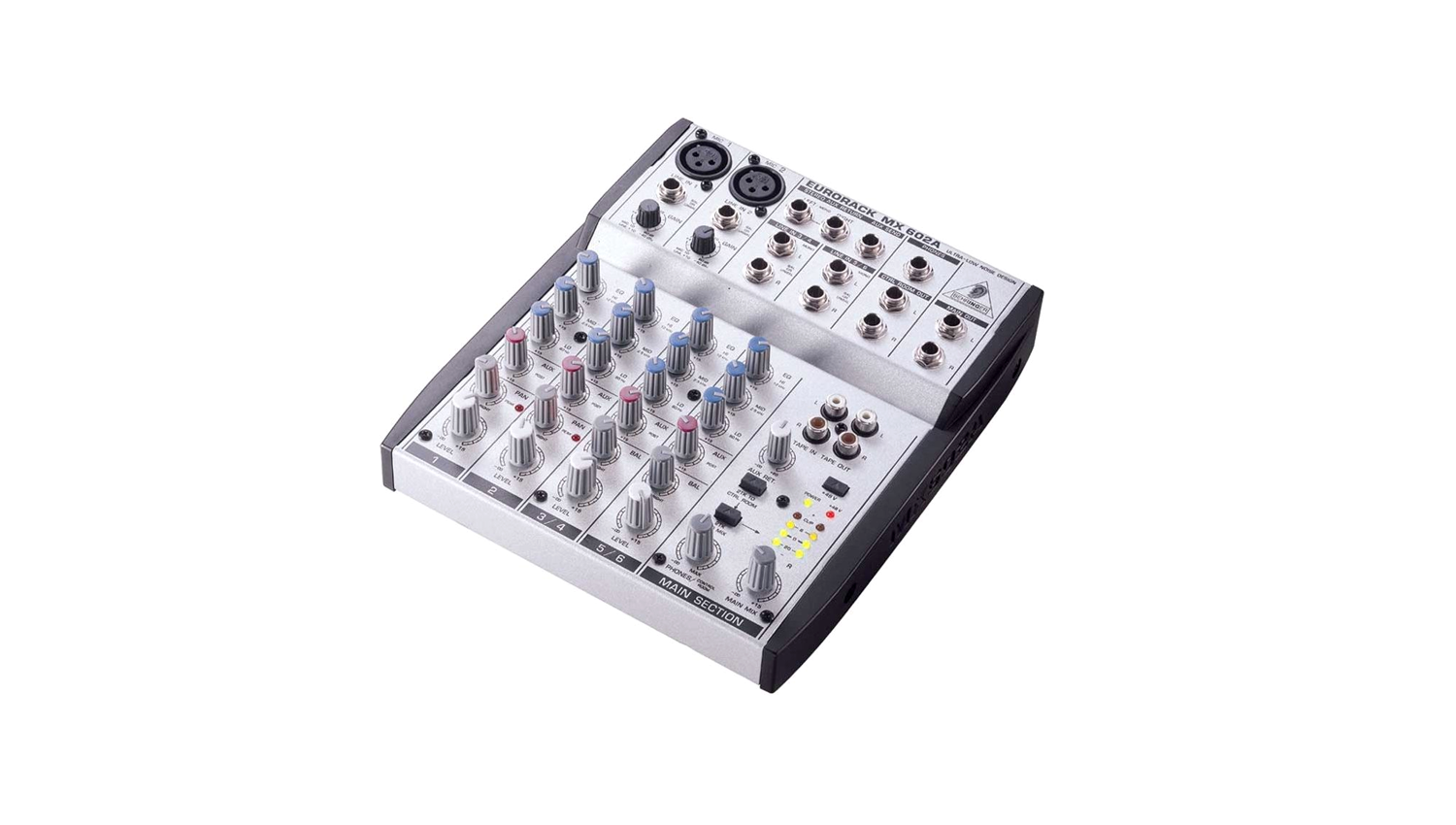User Manual
Eurorack MX602A
SAFETY INSTRUCTIONS
CAUTION: To reduce the risk of electric shock, do not remove the cover (or back). No user serviceable parts inside; refer servicing to qualified personnel.
WARNING: To reduce the risk of fire or electric shock, do not expose this appliance to rain or moisture.
- This symbol, wherever it appears, alerts you to the presence of uninsulated dangerous voltage inside the enclosure – voltage that may be sufficient to constitute a risk of shock.
- This symbol, wherever it appears, alerts you to important operating and maintenance instructions in the accompanying literature. Read the manual.
DETAILED SAFETY INSTRUCTIONS:
All the safety and operation instructions should be read before the appliance is operated.
Retain Instructions:The safety and operating instructions should be retained for future reference.
Heed Warnings:All warnings on the appliance and in the operating instructions should be adhered to.
Follow instructions:All operation and user instructions should be followed.
Water and Moisture:The appliance should not be used near water (e.g. near a bathtub, washbowl, kitchen sink, laundry tub, in a wet basement, or near a swimming pool etc.).
Ventilation:The appliance should be situated so that its location or position does not interfere with its proper ventilation. For example, the appliance should not be situated on a bed, sofa rug, or similar surface that may block the ventilation openings, or placed in a built-in installation, such as a bookcase or cabinet that may impede the flow of air through the ventilation openings.
Heat:The appliance should be situated away from heat sources such as radiators, heat registers, stoves, or other appliance (including amplifiers) that produce heat.
Power Source:The appliance should be connected to a power supply only of the type described in the operating instructions or as marked on the appliance.
Grounding or Polarization:Precautions should be taken so that the grounding or polarization means of an appliance is not defeated.
Power-Cord Protection:Power supply cords should be routed so that they are not likely to be walked on or pinched by items placed upon or against them, paying particular attention to cords and plugs, convenience receptacles and the point where they exit from the appliance.
Cleaning:The appliance should be cleaned only as recommended by the manufacturer.
Non-use Periods:The power cord of the appliance should be unplugged from the outlet when left unused for a long period of time.
Object and Liquid Entry:Care should be taken so that objects do not fall and liquids are not spilled into the enclosure through openings.
Damage Requiring Service:The appliance should be serviced by qualified service personnel when:
- The power supply cord or the plug has been damaged; or
- Objects have fallen, or liquid has been spilled into the appliance; or
- The appliance has been exposed to rain; or
- The appliance does not appear to operate normally or exhibits a marked change in performance; or
- The appliance has been dropped, or the enclosure damaged.
Servicing:The user should not attempt to service the appliance beyond that is described in the Operating Instructions. All other servicing should be referred to qualified service personnel.
WELCOME
Dear Sound Engineer,Welcome to the BEHRINGER EURORACK MX602A and thank you for placing your trust in BEHRINGER products. My most pleasant task is to write this introduction to you, because it is the culmination of many months of hard work for our engineering team. Our daily objective is to be focused on you, the Sound Engineer, and with that focus in mind, it drives us to reach a goal which is unique, and is the backbone of the BEHRINGER philosophy.
That philosophy is very simple, that you the Sound Engineer, are the most important part of the BEHRINGER family. We will not accept anything less for you, than the highest quality, best specified product, at the lowest price. This enables you to express your full creativity without price being a concern.
Due to the hundreds of thousands of satisfied BEHRINGER users around the world, we are able to demand very high quality components at extremely low prices, making the final cost of our products astonishingly low. Why then, shouldn’t we pass the benefit of our good fortune back to you, the Sound Engineer? This enables you to own the type of quality equipment that previously would have cost very much more. It also gives you the confidence that your new equipment uses technology which is leading the way in the field of Audio Design. I would like to thank the following people, whose help on “Project EURORACK” has made it all possible. Everybody has made very personal contributions, starting from the designers of the unit via the many staff members in my company to you, the user of BEHRINGER products.
Can you imagine the feeling of mixing a gold record? We believe a creative composer lies in you and we want to share in your success. Our products are built for people like you – people with a fine ear – and as you have trusted us by buying the BEHRINGER EURORACK, we return your trust by welcoming you into the BEHRINGER family.
Thank you and sincerely yours,Uli Behringer
EURORACK®
6 channel ultra-low noise mic/line mixer
- Ultra-low noise 6-channel, 2-bus mixer
- 2 mono input channels with gold plated XLR and line inputs
- Ultra-low noise discrete mic preamps with +48 V phantom power
- 2 stereo input channels with balanced TRS jacks
- Additional multifunctional stereo aux return
- Extremely high headroom – offering a huge dynamic range
- Balanced inputs for highest signal integrity
- Ultra-musical 3-band EQ on all channels
- Peak LEDs on all mono channels
- Aux Send for external effects and monitoring
- Separate main mix, control room and headphone outputs
- 2-track inputs assignable to main mix, control room / headphone outputs
- Highly accurate 4 segment bargraph meters
- High-quality potentiometers
- Rugged design power supply ensures superior transient response
- State-of-the-art 4580 IC’s and highest quality components ensure crystal-clear audio performance and ultra-low noise performance
- Extremely rugged construction ensures long life even under the most demanding conditions
- Manufactured under the ISO9000 certified management system
1. INTRODUCTION
Congratulations. In purchasing our EURORACK MX602A you have acquired a mixer whose small size belies its incredible versatility and superlative audio performance. Your EURORACK is built to the same outstanding quality as our top-of-the line console, the BEHRINGER EURODESK MX9000.
We recommend that you experiment with your EURORACK away from the pressures of a recording session or live concert, in order to get a feel for it. It is a musical instrument. Learn to play it well.
Next to the specifications in the appendix you will find some pages with drawings showing the front and rear panel of your EURORACK. Keep them turned over, lying to the left of the text pages, while studying the manual. All functions will be numbered consistently throughout the manual, whether they be in the text or on an illustration.
2. EURORACK OVERVIEW
2.1 Architecture
Mono input channelsChannels 1 and 2 are mono, with a choice of balanced mic or line inputs. The vintage-style high-current discrete mic amps are of the same incredible quality as those found on the acclaimed BEHRINGER URODESK MX9000, while a large external power supply ensures low noise and superior transient response at all times.
Stereo input channelsA further 4 line inputs are configured as 2 stereo input channels. These are ideal for accepting outputs from MIDI and other electronic instruments.
Channel outputsA high-quality rotary potentiometer feeds the main mix via a constant-power channel pan potentiometer.
Aux sendThere is one aux send bus on the MX602A, set post-fader (the channel’s volume control).
Stereo line inputsThere is a line-level stereo aux return at the top of the output section. It can be used to return stereo effects or MIDI instruments etc.
In addition, a stereo tape input is provided, which may also be routed to the main mix, giving the MX602A a total of 10 possible inputs during mixing. Channels 1 and 2 on the MX602A have overload LEDs, while the main mix output has 4-segment bargraph meters.
2.2 Packing & warranty
Please take time to have the warranty card filled out completely and return it within 14 days after the date of purchase, so as to be entitled to benefit from our extended warranty. You can find the serial [29] number on the rear panel of your MX602A. Or use our online registration option available on the Internet at www.behringer.com.Your BEHRINGER MX602A was carefully packed in the factory and the packaging was designed to protect the unit from rough handling. Nevertheless, we recommend that you carefully examine the packaging and its contents for any signs of physical damage, which may have occurred in transit. See chapter 7 for details.
♦ If the unit is damaged, please do not return it to us, but notify your dealer and the shipping company immediately, otherwise claims for damage or replacement may not be granted.
2.3 PSU (power supply unit)
Any amplifier circuit is limited in its transient response by the available current. Every mixer has numerous line level operational amplifiers (op-amps) inside. When being driven hard, many desks begin to show signs of stress due to power supply limitations. Not so with the EURORACK. The sound will always stay clean and crisp right up to the operating limits of the op-amps themselves, thanks to the generous 10 W external power supply unit.
♦ Connect only the provided BEHRINGER power supply unit to the MX602A via the AC POWER IN connector . Do not connect the PSU to the EURORACK while the PSU is connected to the mains supply. The correct starting sequence is: connect mixer and PSU and then connect the PSU to the mains.
3. MONO INPUT CHANNEL
Each channel comes with an XLR mic input [1] and a balanced line input on 1/4″ jack [2]. Phantom powering is switchable from the front panel [15]. The gain circuit has a wide range from +10 dB to +60 dB, obviating the need for mic/line switching. The crucial operating levels +4 dBu and -10 dBV are clearly and accurately marked [3].
3.1 Input level setting
Mic channel input level is determined by the gain control [3].In addition to main mix metering, a channel PEAK LED [10] illuminates when a channel is going into overload. These LEDs take their cue from post-EQ. This level sampling is particularly useful when using extreme EQ settings.
There is no Solo or PFL function on the MX602A. To accurately set input follow the procedures given in section 7: “Setting Up”. However, if the PEAK LED does not light the input gain cannot be too high. If a reasonable input level is selected, auditioning a single signal should result in a reading of around 0 dB on the main mix meters [18], provided that both channel and output level controls are set to unity gain (0 dB).
3.2 Equalizer
All mono input channels are fitted with three-band EQ. The upper [4] and lower [6] shelving controls have their frequencies fixed at 12 kHz and 80 Hz respectively. The mid range control [5] has a peaking response, with Q fixed at 2 octaves, frequency at 2.5 kHz. All three bands have up to 15 dB of cut and boost, with a centre detent for “off”.
3.3 Aux send
The aux send [7] is mono, post-EQ and post-fader.For almost all FX send purposes, you will want aux sends to be post-fader, so that when a channel level is adjusted, any reverb send from that channel follows the channel volume. Otherwise, when the volume control is turned down, the reverb from that channel would still be audible. For cueing purposes, aux sends will usually be set pre-fader, i.e. independent of the channel volume.
3.4 Fading and panning
Level to the main mix bus is ultimately determined by the channel volume control [9] .Channel pan [8] positions the output of the channel in the stereo field. Its constant-power design ensures there are no level discrepancies whether a signal is hard-panned, centre-stage, or somewhere in between. Such pin-point accuracy will be a revelation if you have been working on consoles with lower quality circuits.
4. STEREO INPUT CHANNEL
Each stereo channel comes with two balanced line level inputs on 1/4″ TRS jacks [25] , for left and right signals. When only the left input is connected, the channel operates in mono.
4.1 Input level setting
The stereo inputs are designed for any line level signal. Most line level sources such as MIDI instruments and FX units will have their own output level control. Those that don’t, like CD-players, all have an output level within the scope of the MX602A. When the channel and master fader are set to unity gain the meters should read between -4 and +7 dB. Remember that there is 15 dB gain on both the channel as well as master fader. If a reasonable input level is selected, auditioning a single signal should result in a reading of around 0 dB on the main mix meters [18] , provided that both channel and output level controls are set to unity gain (0 dB).
4.2 Equalizer
The EQ is in principle identical to that on mono channels (see 3.2), except that the EQ is stereo, of course! A stereo equalizer is generally preferable to using two mono equalizers when EQ-ing a stereo signal, as often discrepancies between left and right settings can occur.
4.3 Aux send
It is the same as for mono channels (see 3.3). Note that a mono sum is taken from the stereo input.
4.4 Volume control and panning/balancing
The only difference here from the mono channel described in 3.4 is in the implementation of the balance control [8]. When a channel is run in stereo, this control determines the relative balance of the left and right channel signals being sent to the left and right main mix buses. For example, with the balance control turned fully clockwise, only the right portion of the channel’s stereo signal will be added to the main mix.
If a stereo channel is run in mono (only the left input connected), the balance control acts as a pan in the normal way.
5. MAIN SECTION
5.1 Aux send
This is on a 1/4″ unbalanced jack [23] at +4 dBu. No master aux send level pot is provided. However, you can use the input level control of your effects unit to match the output level from the EURORACK. If your effects unit does not have an input gain, then remember that every channel aux send has up to 15 dB gain, which should be more than enough to drive any effects unit.
5.2 Stereo line input
Aux returnYour EURORACK MX602A is equipped with a stereo aux return [22]. If only the left socket has a jack connected, the aux return operates in mono and is permanently assigned to the main mix. The AUX RET. control [11] determines the level of the aux return signal. It is automatically assigned to the main mix.
2-track in/output This unbalanced stereo line input incorporates a flexible routing system.When the switch “2TK TO MIX” [13] is depressed, the input is assigned to the main mix, like the aux return. Use this configuration when you need to create extra line inputs for MIDI keyboards etc. However, with “2TK TO CONTROL ROOM” [12] depressed, the input is now assigned to the control room output. This routing mode enables off-tape monitoring of a stereo recording to be effected at the flick of aswitch.
5.3 Metering
Main mix level is displayed on a pair of accurate 4 segment bargraph peak meters [18] . Two further LEDs indicate power on [17] and +48 V DC phantom power present [16].
The main mix bargraph meters should average around 0 dB during loud passages. If they read persistently higher, or are peaking above +22 dB (PEAK LED of the display) reduce the level. When both the main mix volume and the channel volume, are set below or around “0” (unity gain), lower the instrument / FX unit output level.
5.4 2-track input / main mix output
InputA 2-track input, on RCA phono jacks [20] , provides easy connection to DAT and other professional and semiprofessional audio equipment. The 2-track input is primarily for auditioning mix playback from tape. Switch [12] “2TK TO CTRL ROOM” routes this signal to the studio monitors. However, it can also be routed to the main mix via switch [13] “2TK TO MIX”. Here [12] should be disengaged, or you will be listening to the 2-track signal twice over! With [13] depressed you have another stereo line input available to the mix. Tip: The 2-track Input could be “normalled” to the output of a HiFi pre-amp, allowing you to monitor extra sources such as vinyl, cassette, CD etc.
OutputA single pair of unbalanced TS jacks [27] deliver the main mix output to your 2-track recorder (or PA system). RCA phono jack outputs [21] are also provided for easy connection to DAT, cassette desk etc. Level is ultimately determined by a precision main mix volume control [19] .
5.5 Monitoring
The PHONES/CONTROL ROOM volume control determines the level to the PHONES output and CTRL ROOM OUT [26]. The L/R meters follow the main mix.
6. CONNECTIONS
You will need a lot of cables for different purposes – see the following figures to make sure you have got the right ones. Unbalanced equipment may be connected to balanced inputs/outputs. Either use mono 1/4″ jacks or connect ring and sleeve of TRS jacks.
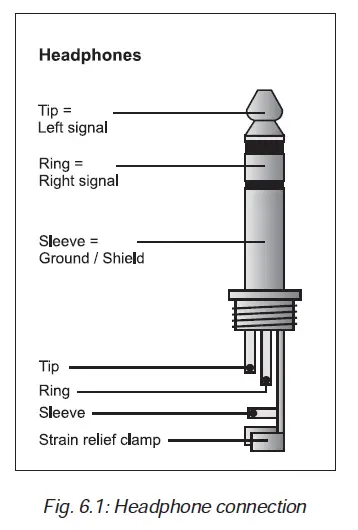 Phantom power (+48 V DC) is provided. This can be switched on or off by the +48 V phantom switch . Care should be taken NOT to plug mics into the console (or stagebox) while the phantom power is on. Also, mute the monitor/PA speakers when turning phantom power on or off. Allow the system to adjust for a couple of seconds after engaging phantom power before setting input gains.
Phantom power (+48 V DC) is provided. This can be switched on or off by the +48 V phantom switch . Care should be taken NOT to plug mics into the console (or stagebox) while the phantom power is on. Also, mute the monitor/PA speakers when turning phantom power on or off. Allow the system to adjust for a couple of seconds after engaging phantom power before setting input gains.
If possible, connect the unit to other devices in a balanced configuration to allow for maximum interference immunity.
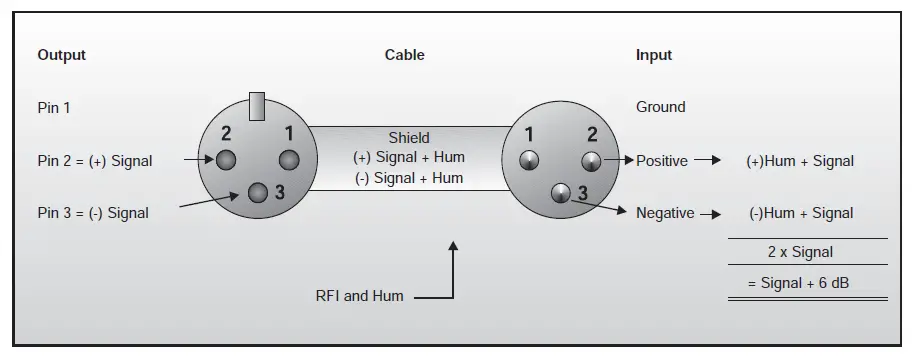
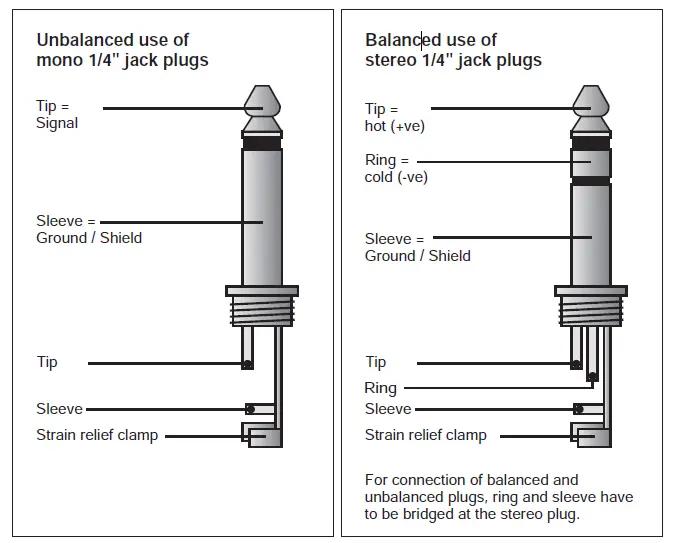

7. SETTING UP
7.1 Selecting inputs
1) Mono channels accept mic or line inputs. If you are using the mic input, make sure nothing is connected to the line input (and vice-versa).
The mic inputs are more sensitive than the line inputs. Do not connect mics with phantom power switched on. Never use unbalanced mic cables with the phantom power switched on ever! Shorting the +48 V to earth can cause serious damage.
2) Stereo channels accept any line level signals. Any stereo channel can be run in mono simply by connecting into the left jack socket only. These channels are suitable for a variety of line-level sources including MIDI instruments and tape returns from multitrack.
3) Stereo aux returns are primarily designed for returning effects units, though these too may be given over to tape returns or MIDI instrument outputs.
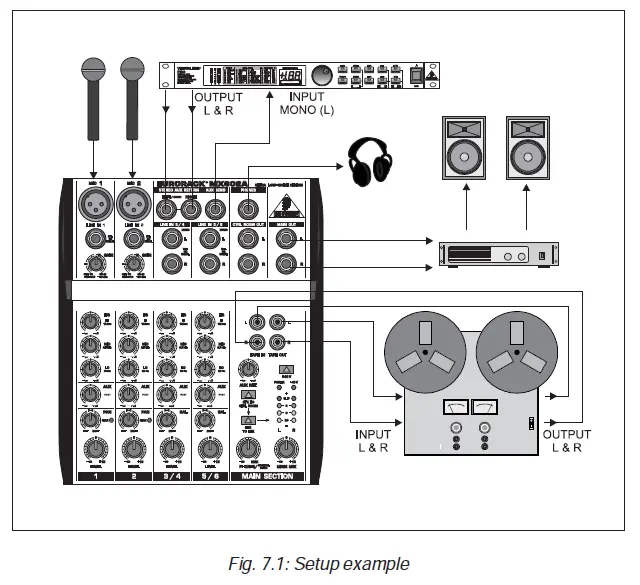
7.2 Initializing channels for gain setting
- Set gain to minimum and all aux sends to off (fully counter-clockwise).
- Set EQ to flat (all knobs at 12 o’clock).
- Set the output level to unity gain ([19] set to “0”).
7.3 Auditioning a signal and setting up a channel
- Turn up channel volume to unity gain ( [9] to “0”). All other channel volume controls should be set fully counter-clockwise (minus infinity).
- Generate a signal, i.e. a voice through a microphone. There should now be some activity at the bargraph meters [18] .
- For mic channels: Adjust the gain control [3] until transient peaks are regularly hitting +6 dB. Continuous signals should not exceed 0 dB.
- For stereo channels and other stereo line inputs, use the output volume of the source instrument or FX unit to effect gain adjustment until transient peaks are regularly hitting +6 dB. Continuous signals should not exceed 0 dB.
- Altering EQ will affect a channel’s gain. If EQ is adjusted at any time, repeat steps 2 and 3 or 4.
- Turn the channel’s volume control fully counter-clockwise. Move onto next channel and repeat steps 1 thru 6.
- Once all channel inputs have been set for level, turn all active channel level controls back to 0 dB. You are now ready to start mixing.
7.4 Desk normalization
All board settings should be set to the normal default condition before or after every session. Usually volumes are set to zero (minus infinity), EQs set flat, and Aux Sends turned fully counter-clockwise etc.
7.5 Recording levels
When recording to digital, it’s a good idea to keep the recorder’s peak meters below 0 dB. Most (not all, esp. samplers) read 0 dB with some headroom left. This is because, unlike with analogue, the onset of digital distortion is as sudden as it is horrible. If you really want to take your recording level to the limit (and fully exploit 16-bit digital’s 96 dB dynamic range for example), you’ll have to do some calibrating. How to do it? Well, you could run a tone at 0 dB from the mixer and use that as your DAT or ADAT reference. But your DAT or ADAT may be way under its maximum input limit. Probably a better way to work out just how hard you can drive your recorder is to incrementally increase the record level until the onset of digital distortion, subtract, say, 5 or 10 dB, and never exceed that level. Engage “peak hold” on your recorder before recording if you want to confirm that you haven’t. Peak meters read more-or-less independent of frequency. Aim for 0 dB recording level for all signals.
8. APPENDIX
8.1 Specifications
Mono input channels
- Mic Input : electronically balanced, discrete input configuration
- Mic E.I.N. (22 Hz – 22 kHz) : -129.5 dBu, 150 Ohm source-117.3 dBqp, 150 Ohm source-132.0 dBu, input shorted-122.0 dBqp, input shorted
- Bandwidth : 10 Hz to 60 kHz, +/- 3 dB
- Distortion : (THD&N) 0.007% at +4 dBu, 1 kHz, bandwidth 80 kHz
- Gain range : +10 dB to +60 dB
- Signal-to-noise ratio : 113.6 dB
- Line input : electronically balanced
- Bandwidth : 10 Hz to 60 kHz, +/- 3 dB
- Distortion : (THD&N) 0.007% at +4 dBu, 1 kHz, bandwidth 80 kHz
- Line level range : +10 dBu to -40 dBu
Equalization
- Hi shelving : 12 kHz, +/- 15 dB
- Mid range : 2.5 kHz, +/- 15 dB
- Lo shelving : 80 Hz, +/- 15 dB
Stereo inputsLine input : unbalancedBandwidth : 10 Hz to 55 kHz, +/- 3 dBDistortion : (THD&N) 0.007% at +4 dBu, 1 kHz, bandwidth 80 kHz
EqualizationHi shelving : 12 kHz, +/- 15 dBMid range : 2.5 kHz, +/- 15 dBLo shelving : 80 Hz, +/- 15 dB
Main mix sectionMax output : +22 dBu unbalancedAux send max out : +22 dBu unbalancedControl room out : +22 dBu unbalancedSignal to noise ratio : 112 dBEquivalent input noise : -90 dBu (all channels open, unity gain)
Power supplyMains voltages USA/Canada : 115 V ~, 60 Hz, power supply unit MXUL3U.K./Australia : 240 V ~, 50 Hz, power supply unit MXUK3Europe : 230 V ~, 50 Hz, power supply unit MXEU3Japan : 100 V ~, 60 Hz, power supply unit MXJP3
Physical(H * W * D) : 1 4/5″ / 1 1/2″ (46 / 37 mm) * 7 2/5″ (188 mm) * 8 1/3″ (212 mm)Net weight : 1.3 kg (PSU not included)Shipping weight : 2 kg
BEHRINGER is constantly striving to maintain the highest professional standards. As a result of these efforts, modifications may be made from time to time to existing products without prior notice. Specifications and appearance may differ from those listed or shown.
8.2 Front & back views



8.3 Block diagram

9. WARRANTY
§ 1 WARRANTY CARD/ONLINE REGISTRATION
To be protected by the extended warranty, the buyer must complete and return the enclosed warranty card within 14 days of the date of purchase to BEHRINGER Spezielle Studiotechnik GmbH, in accordance with the conditions stipulated in § 3. Failure to return the card in due time (date as per postmark) will void any extended warranty claims.
Based on the conditions herein, the buyer may also choose to use the online registration option via the Internet (www.behringer.com or www.behringer.de).
§ 2 WARRANTY
- BEHRINGER (BEHRINGER Spezielle Studiotechnik GmbH including all BEHRINGER subsidiaries listed on the enclosed page, except BEHRINGER Japan) warrants the mechanical and electronic components of this product to be free of defects in material and workmanship for a period of one (1) year from the original date of purchase, in accordance with the warranty regulations described below. If the product shows any defects within the specified warranty period that are not due to normal wear and tear and/or improper handling by the user, BEHRINGER shall, at its sole discretion, either repair or replace the product.
- If the warranty claim proves to be justified, the product will be returned to the user freight prepaid.
- Warranty claims other than those indicated above are expressly excluded.
- To obtain warranty service, the buyer (or his authorized dealer) must call BEHRINGER (see enclosed list) during normal business hours BEFORE returning the product. All inquiries must be accompanied by a description of the problem. BEHRINGER will then issue a return authorization number.
- Subsequently, the product must be returned in its original shipping carton, together with the return authorization number to the address indicated by BEHRINGER.
- Shipments without freight prepaid will not be accepted.
§ 4 WARRANTY REGULATIONS
- Warranty services will be furnished only if the product is accompanied by a copy of the original retail dealer’s invoice. Any product deemed eligible for repair or replacement by BEHRINGER under the terms of this warranty will be repaired or replaced within 30 days of receipt of the product at BEHRINGER.
- If the product needs to be modified or adapted in order to comply with applicable technical or safety standards on a national or local level, in any country which is not the country for which the product was originally developed and manufactured, this modification/adaptation shall not be considered a defect in materials or workmanship. The warranty does not cover any such modification/adaptation, irrespective of whether it was carried out properly or not. Under the terms of this warranty, BEHRINGER shall not be held responsible for any cost resulting from such a modification/adaptation.
- Free inspections and maintenance/repair work are expressly excluded from this warranty, in particular, if caused by improper handling of the product by the user.This also applies to defects caused by normal wear and tear, in particular, of faders, potentiometers, keys/buttons and similar parts.
- Damages/defects caused by the following conditions are not covered by this warranty:♦ misuse, neglect or failure to operate the unit in compliance with the instructions given in BEHRINGER user or service manuals.♦ connection or operation of the unit in any way that does not comply with the technical or safety regulations applicable in the country where the product is used.♦ damages/defects caused by force majeure or any other condition that is beyond the control of BEHRINGER.
- Any repair or opening of the unit carried out by unauthorized personnel (user included) will void the warranty.
- If an inspection of the product by BEHRINGER shows that thedefect in question is not covered by the warranty, the inspection costs are payable by the customer.
- Products which do not meet the terms of this warranty will be repaired exclusively at the buyer’s expense. BEHRINGER will inform the buyer of any such circumstance. If the buyer fails to submit a written repair order within 6 weeks after notification, BEHRINGER will return the unit C.O.D. with a separate invoice for freight and packing. Such costs will also be invoiced separately when the buyer has sent in a written repair order.
§ 5 WARRANTY TRANSFERABILITY
This warranty is extended exclusively to the original buyer (customer of retail dealer) and is not transferable to anyone who may subsequently purchase this product. No other person (retail dealer, etc.) shall be entitled to give any warranty promise on behalf of BEHRINGER.
§ 6 CLAIM FOR DAMAGES
Failure of BEHRINGER to provide proper warranty service shall not entitle the buyer to claim (consequential) damages. In no event shall the liability of BEHRINGER exceed the invoiced value of the product.
§ 7 OTHER WARRANTY RIGHTS AND NATIONAL LAW
- This warranty does not exclude or limit the buyer’s statutory rights provided by national law, in particular, any such rights against the seller that arise from a legally effective purchase contract.
- The warranty regulations mentioned herein are applicable unless they constitute an infringement of national warrant
The information contained in this manual is subject to change without notice. No part of this manual may be reproduced or transmitted in any form or by any means, electronic or mechanical, including photocopying and recording of any kind, for any purpose, without the express written permission of BEHRINGER Spezielle Studiotechnik GmbH.BEHRINGER, EURORACK and EURODESK are registered trademarks.ALL RIGHTS RESERVED.© 2001 BEHRINGER Spezielle Studiotechnik GmbH.BEHRINGER Spezielle Studiotechnik GmbH, Hanns-Martin-Schleyer-Str. 36-38, 47877 Willich-Münchheide II, GermanyTel. +49 (0) 21 54 / 92 06-0, Fax +49 (0) 21 54 / 92 06-30
Read More About This Manual & Download PDF:
Eurorack MX602A User Manual –
Eurorack MX602A User Manual –
Questions about your Manual? Post in the comments! .
[xyz-ips snippet=”download-snippet”]

